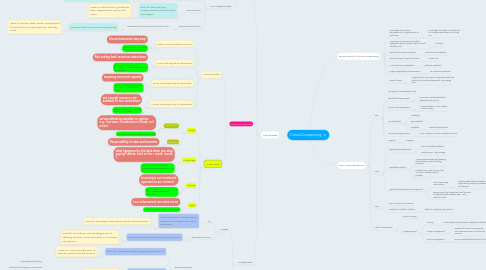
1. Cloud Risks
1.1. People Risks
1.1.1. Multi-tenancy Risks
1.1.1.1. Perfomance
1.1.1.1.1. Several users utilizing the same cloud hardware/storage
1.1.1.2. Vulnerability to hackers
1.1.1.2.1. Risk of data being attacked
1.1.2. User Management Risks
1.1.2.1. Identity management and authentication
1.1.2.1.1. Risk of unauthorized usage/access, or authorized users not being able to access
1.1.2.2. Data Access
1.1.2.2.1. Some data should be encrypted or unaccessible
1.1.2.3. User Permissions
1.1.2.3.1. Risk of users having unwarranted administrative privileges
1.1.2.4. Physical access to servers
1.1.2.4.1. Unauthorized users having access to data center
1.2. Financial and Legal Risks
1.2.1. Fiancial Risks
1.2.1.1. Return on Investment (ROI)
1.2.1.1.1. Cloud momentum may stop
1.2.1.1.2. Protect: perform a financial analysis prior migration
1.2.1.2. Not Scaling back resourses
1.2.1.2.1. Not scaling back resourses when done
1.2.1.2.2. Protect: Implement financial monitoring, usage and maximums for all purchases
1.2.1.3. Over provisioning of resourses
1.2.1.3.1. acquiring too much capacity
1.2.1.3.2. Prevent: conduct needs analysis with Subject Matter Experts (SMEs)
1.2.1.4. Under provisioning of resourses
1.2.1.4.1. not enough resources are available or too constrained
1.2.1.4.2. Protect: Monitor usage and get feedbacks from users
1.2.2. Legal Risks
1.2.2.1. Location
1.2.2.1.1. regional events
1.2.2.1.2. Jurisdiction
1.2.2.2. Failure to pay
1.2.2.2.1. what happened to the data when you stop paying? delete, held on for 1 week, month ?
1.2.2.2.2. Protection: Clearly define data retention due to non-payment in the SLA
1.2.2.3. Licensing
1.2.2.3.1. Licensing is not monitored agreements are violated
1.2.2.3.2. Protection: Educate VM creators on licensing agreements and restrictions
1.2.2.4. Seizure
1.2.2.4.1. Law enforcement can seize server
1.2.2.4.2. Mitigate: Replicate data or private cloud
1.3. Availability Risks
1.3.1. Outages
1.3.1.1. ISP
1.3.1.1.1. Risk of internet outage which results in no access to cloud resources
1.3.1.2. Termination of Service
1.3.1.2.1. Risk of primary cloud vendor going down
1.3.2. Backup and Disaster Recovery
1.3.2.1. Business Continuity
1.3.2.1.1. Risk of a disastrous halt of service/production
1.3.2.1.2. Risk of having an undefined backup management
1.3.2.2. Disaster Recovery
1.3.2.2.1. Risk of data lost during site disaster
1.3.2.2.2. Risk of not being able to access replicated data
2. Economics of cloud computing
2.1. Fixed application labour amortized over a large number of customers
2.1.1. Meaningful reduction in overall cost for complex application in the long run
2.2. Larger pool of resources, smoother aggregate demand profile, higher overall utilization rate.
2.2.1. Cheaper
2.3. Reduce time-of-day variability
2.3.1. Synchronized workplace
2.4. Pay-as-you-go pricing, self-service
2.4.1. Saves cost
2.5. Multi-resource diversification
2.5.1. Optimize workload
2.6. Higher expectation of performance
2.6.1. No resource constraints
2.7. Cost of Power
2.7.1. Large provider can pay for inexpensive electricity due to bulk purchase agreement. Low energy cost.
3. ROI Considerations
3.1. IaaS
3.1.1. Storage and Computation costs
3.1.2. Bandwidth requirements
3.1.2.1. It is online, need bandwidth to download and upload
3.1.3. Service Level agreements
3.1.3.1. Promised uptime. More uptime = more money
3.1.4. Cloud benefits
3.1.4.1. Scalability
3.1.4.2. Expandability
3.1.4.3. Flexibility
3.1.4.3.1. Speed of deployment
3.1.5. Security and governance
3.1.5.1. More costly as it is more complex for cloud
3.1.6. Support
3.1.6.1. IT support
3.2. PaaS
3.2.1. Application Development
3.2.1.1. Cost of hardware/software
3.2.1.2. Possible 30% - 40% savings
3.2.2. Application Testing
3.2.2.1. Avoid cost associated with keeping extra hardware just for testing purposes
3.2.2.2. Possible 70% - 90% saving, if we can find a suitable service provider
3.2.3. Application Deployment & Mangement
3.2.3.1. Auto Provisioning Auto Scaling
3.2.3.1.1. Instantly added those needed to support application processing, database processing and storage
3.2.3.2. Saving come form being free from the work to upgrading data centers, 50% - 60% reduction costs
3.3. SaaS
3.3.1. App in-house vs on-demand
3.3.2. Evaluation model for software
3.3.2.1. Different modes of subscriptions
3.4. Other Consideration
3.4.1. CAPEX vs OPEX
3.4.2. Migration Issues
3.4.2.1. Security
3.4.2.1.1. Checking the cloud provider's audit and certification.
3.4.2.2. Vendor Management
3.4.2.2.1. Requires the need to manage SLA and customers have to monitor the services.
3.4.2.3. Technical Integration
3.4.2.3.1. Services offered/built into the cloud.
